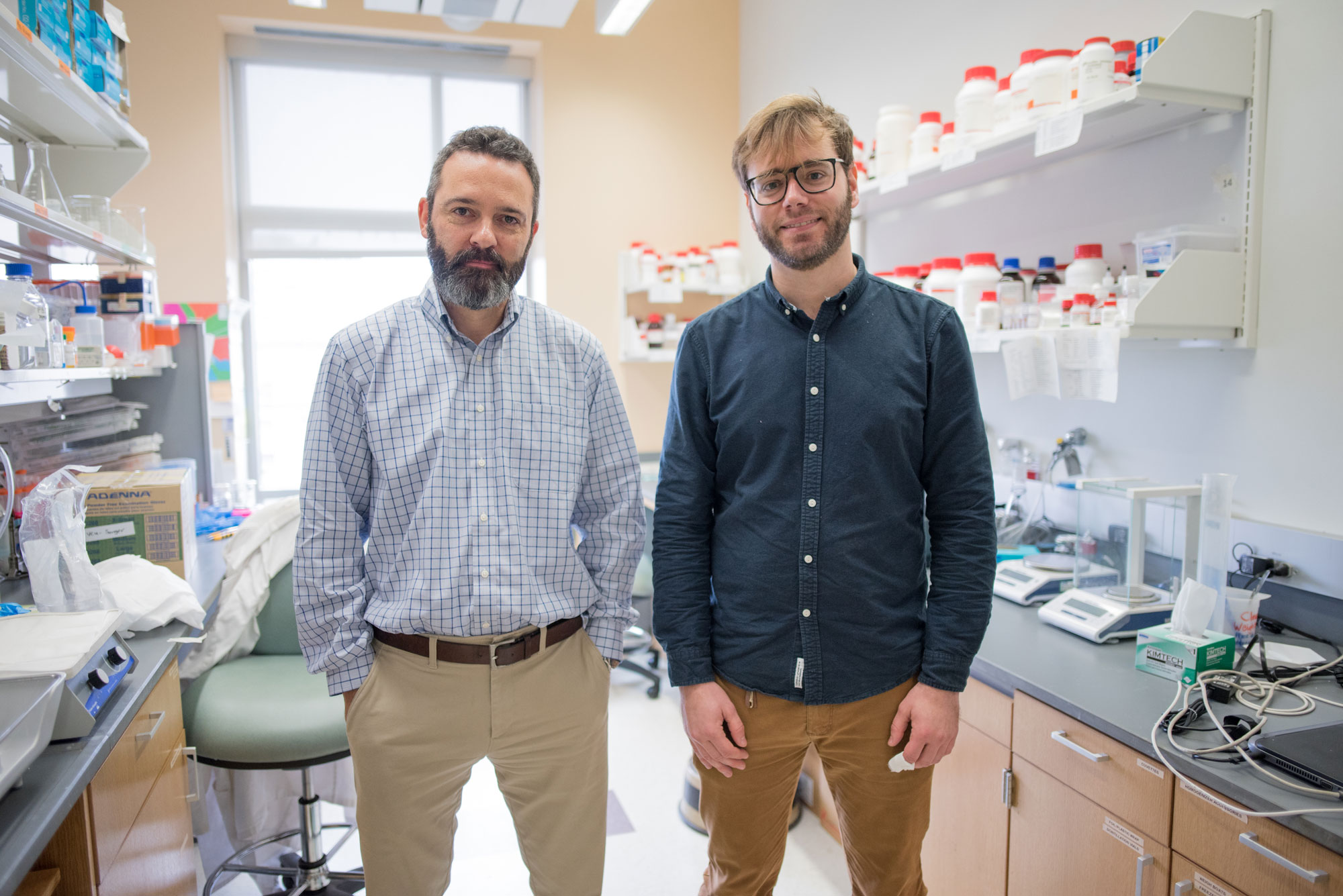Scientists from the VCU School of Medicine are exploring how psychedelic drugs work in the brain and how long these changes might last – research that could lead to new treatment options for depression.
In a paper featured on the cover of the October 19 issue of the journal Cell Reports, a team of researchers led by Mario de la Fuente Revenga, Ph.D., and Javier González-Maeso, Ph.D., demonstrated that a single dose of a psychedelic drug related to psilocybin, the psychoactive compound in so-called “magic mushrooms,” produces fast, long-lasting antidepressant effects in mice. These effects were correlated by collaborators from Virginia Tech with several structural and genetic changes that occurred in neurons, some of which also overlapped with genetic risks for certain psychiatric conditions.
“For the first time, we have found that there is indeed a very long-lasting effect at the molecular level that persists long after the immediate effects of a psychedelic dissipate,” said de la Fuente, a postdoctoral fellow and first author of the paper. “We don’t have the direct causation, but we are very adamant in our suggestion that this could be the scaffold that underlies improvements in psychological domains that have been observed in previous clinical research studies.”
Rewiring the brain
Changes in the structure of neurons are important because such modifications can impact how the brain is wired, and as a result, how we think, feel and behave. When it comes to depression, previous research suggests that the spines of neurons in the prefrontal cortex, an area of the brain that controls anxiety and regulates mood, become less dense. Therefore, reversing this deficit has developed into a promising avenue for potential new treatments.
In the Cell Reports study, adult mice given a single dose of 2,5-dimethoxy-4-iodoamphetamine (DOI), a lesser-known psychedelic widely used in research, showed an increase in the number of dendritic spines in the prefrontal cortex and a decrease in behaviors associated with depression. This “rewiring” effect could be seen within 24 hours after administration.
“What we showed is that with a single dose of the psychedelic, there was an increase in the density of the dendritic spines in the prefrontal cortex after the drug had been metabolized,” said González-Maeso, a professor in the Department of Physiology and Biophysics. “Based on our previous research, to see similar effects with other drugs, including first-line antidepressants, they require continuous daily treatment for weeks. In the case of psychedelics, a single dose gets the job done.”
This delay in the onset of antidepressant treatment effects also occurs in humans and underlies the need for faster acting therapeutic options – something many are hoping psychedelics can provide. But while this new research bolsters previous clinical and laboratory studies demonstrating psychedelics’ “remarkable” effects, it also raises important questions about side effects, according to de la Fuente and González-Maeso.
Potential constraints
“One of the limitations of using these drugs in the clinic is precisely that they are psychedelics. You cannot give these drugs over the counter; they have to be controlled,” said González-Maeso. “The ultimate goal would be to develop similar drugs that still induce these impressive antidepressant effects but don’t produce hallucinations.”
A potential barrier to achieving this goal could be that the receptor in the brain that de la Fuente and González-Maeso identified as mediating DOI’s antidepressant effects, the serotonin 5-HT2A receptor, is the same one responsible for the hallucinations people experience after taking psychedelics.
“Historically, the pharmaceutical industry has stayed away from anything that could remotely come close to activating this receptor. It is encouraging to see that 5-HT2A-rich pharmacology could hold a bright side to it,” de la Fuente remarked.
VCU has a track record of furthering our understanding of psychedelics’ mechanism of action. “Emeritus Professor Richard D. Glennon from the Department of Medicinal Chemistry was the first to propose in the 1980s that 5-HT2A is the switch that psychedelics primarily act upon. We are actively working on segregating the different effects that psychedelics mediate to cater their action to psychiatric patients’ needs,” de la Fuente added.
In this quest, collaborators Chang Lu, Ph.D., Bohan Zhu and their team at Virginia Tech turned their eye to how psychedelics affect the biology within neurons. They observed that a single exposure to DOI prompted a slew of long-lasting changes in the mouse brain that remained imprinted in the epigenetic environment, which is made up of chemical compounds that help control gene activity without changing the DNA sequence.
“Most of the genes and most of the pathways impacted have to do with, let’s say, ‘good things’ – genes that were important in memory and plasticity. But then we also found that some of the genes that were affected by this single dose of DOI had been previously linked to several psychiatric disorders, for example, depression, schizophrenia and attention deficit hyperactivity disorder,” González-Maeso explained. “So, while psychedelics can induce these therapeutically relevant effects, they may interact with other built-in risk factors in ways that we are not aware of yet. We need more investigation to identify any potential side effects.”
According to Peter Buckley, M.D., dean of the VCU School of Medicine, this research demonstrates why basic science and clinical research should go hand in hand.
“Understanding the underlying biological mechanisms of potential new treatments is extremely important for the well-being of all patients, but this is especially true for substances like psychedelics. I commend the researchers’ efforts to gather and share this knowledge through publications in prestigious journals such as this one,” Buckley said.
Additional co-authors on the Cell Reports study are Justin M. Saunders, Rudy Toneatti, Salvador Sierra, Jennifer T. Wolstenholme and Patrick M. Beardsley from the VCU School of Medicine; Lynette B. Naler and Zirui Zhou from the Virginia Tech Department of Chemical Engineering; and Christopher A. Guevara and George W. Huntley from Icahn School of Medicine at Mount Sinai.
The work was partly supported by grants from the National Institutes of Health.
